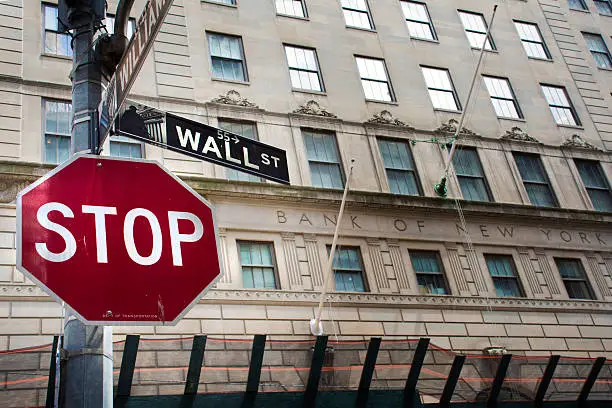When you hear the words trading halt or suspension, what do you think of? What is the difference between a trading halt vs suspended trading? Do you know?
In this article, we will discuss the differences between a trading halt and a trading suspension. We will also look at some of the reasons why each might be implemented.
What is a trading halt?
A trading halt is when trading of a security is temporarily stopped. When trading is halted, no trades can occur until it resumes. Halts are usually implemented by exchanges and can happen for a variety of reasons.
Reasons why trading is halted
This can be done for many reasons, including but not limited to:
- The release of material news
- Volatile market conditions
- Orders imbalance
Let's explore these main reasons in more detail and what you can expect if trading is halted in any of these cases.
The release of material news
One common reason for a trading halt is the release of material news. If a company is releasing earnings or some other type of news that could potentially move the stock price, trading may be halted to allow investors time to digest the news.
Volatile market conditions
Sometimes, trading is halted due to volatile market conditions. This can happen if there is a sudden drop in the stock market. Halting trading gives investors time to reassess the situation and decide if they want to sell or buy.
Orders imbalance
An orders imbalance occurs when there are more buy orders than sell orders or vice versa. This can cause a stock price to spike or drop, so trading may be halted to prevent any further price movement.
As you can see, the reason for halting is to protect investors from making trades based on false or misleading information. It also gives them time to assess the situation and make informed decisions. Exchanges can also ensure that there is enough liquidity for trades to occur. This is important because if there are too many buy or sell orders, it can cause the stock price to spike or dramatically drop.
How does a trading halt work?

The way a trading halt works is pretty simple. When a company wants to halt trading, they submit a request to the exchanges where they are listed. The exchanges then review the request and decide whether or not to approve the request.
If the exchange approves the request, they will halt trading in that security for some time. If the exchange itself wants to halt trading, it will do so without any prior notice.
This can happen in cases of extreme market volatility or system issues. When trading resumes, the exchange will announce it and trading will resume as normal.
How long does a trading halt lasts
In most cases, trading halts will last for a few minutes to a few hours. However, there have been cases where trading has been halted for days or even weeks. It all depends on the reason for the halt and how long it takes for the situation to be resolved.
What can investors do when there is a trading halt?
During a trading halt, investors are not able to buy or sell shares of the company's stock. This can be frustrating for investors who want to trade the stock, but it is important to remember that trading halts are put in place for a reason.
They give the company time to release important information that could impact the price of the stock.
If you are interested in trading a stock that has been halted, it is important to pay attention to the news. Once the halt is lifted, trading will resume and the price of the stock could move quickly.
It is also important to remember that not all trading halts are created equal. Some companies may halt trading because they are about to release good news, while others may do it because they are under investigation.
Pay close attention to the reason for the halt before making any decisions. By researching, being patient, and controlling your emotions, you can make the best investment decision when the halt is lifted and trading resumes.
What is suspended trading?
A trading suspension is similar to a trading halt, but it is more severe. A trading suspension means that trading in the security has been halted indefinitely and may never resume trading. If you own shares of a company that has been suspended, you may not be able to sell your shares.
This can be frustrating, but it is important to remember that trading suspensions are put in place for a reason. They are necessary to investigate potential wrongdoings to protect the investors.
Reasons why trading is suspended
Suspensions in the stock market can happen for a variety of reasons, such as bankruptcy or fraud. When a company files for bankruptcy, the court may order a trading suspension to protect investors.
This gives the company time to reorganize and come up with a plan to pay back its debts. A trading suspension can also happen if the SEC suspects that a company has committed fraud. The SEC may suspend trading to investigate the allegations.
If the allegations are true, the company may be fined or even shut down. Another cause of suspensions is when a company fails to meet the listing requirements of an exchange. This can happen if the company does not file its financial reports on time or if its stock price falls below a certain level.
Finally, as an investor, you should always be aware of this risk. Suspensions can happen without any warning, and you could lose a lot of money if you're not careful. When researching a company, be sure to check if there have been any recent suspensions. This information is typically available on the SEC's website.
How suspended trading works

When the SEC halts trading in a stock, it does so to protect investors from making decisions based on false or misleading information. The suspension usually lasts for ten days, during which time the SEC investigates the circumstances that led to the halt.
If they determine that there was indeed fraud or manipulation involved, they may take action against the responsible parties. In some cases, however, the trading suspension is lifted without any further action.
If you're wondering how a trading suspension affects your portfolio, the answer depends on how much of the affected stock you own. If it's a small position, you may not even notice the impact.
But if it's a significant portion of your portfolio, you could see some serious losses. Of course, if the stock is eventually reinstated, you may have an opportunity to recoup your losses. But no guarantee will happen.
So, if you're thinking about investing in a company whose stock has been suspended, it's important to be aware of the risks. Make sure you understand the reason for the suspension and what the SEC's investigation could mean for the future of the company. Otherwise, you could end up on the losing end of a trade.
How long do trading suspensions last?
As mentioned, the initial suspension period lasts 10 business days. This gives the SEC time to investigate the reasons for the halt and decide if any further action needs to be taken. If the SEC decides to take action, the trading suspension could last for months or even years.
But if no action is taken, the stock may be reinstated and trading can resume. It is difficult to say when trading will resume after a suspension. It is up to the SEC to decide and investors can't do anything to speed up the process.
Ultimately, It all depends on the reason for the halt and how long the SEC's investigation takes. If you're thinking about buying shares of a company, be patient and wait for the situation to unfold.
It might turn out that the stock is a bargain and the investigation is benign. But it could also end up being worthless and you could lose everything you invested. So do your homework before making any decisions.
How do you know which stocks are suspended?
The simplest way to know which stocks are currently suspended is to visit the SEC website, and it will show all the stocks that are under suspension. It will also provide you with the date, as well as the reasons why the trading is suspended.
What is the difference between a trading halt vs suspended trading?

A trading halt is a temporary pause of trading in a security. This can happen for many reasons, including pending news or regulatory action. A suspension, on the other hand, is a more serious matter.
A suspension can be imposed by a regulator or an exchange, and it usually means that there is some sort of fraud or irregularity going on. Suspensions can last for days, weeks, or even longer.
Finally, delisting occurs when a security is removed from an exchange altogether. This usually happens because the company has gone bankrupt or has otherwise failed to meet the listing requirements of the exchange. This is rare for trading halts but companies that are suspended face a greater risk of this happening.
Conclusion
When trading in securities is halted or suspended, it can have a big impact on investors and consequently on the stock. First of all, it is not possible to buy or sell the security during that time. This can cause the price of the security to go up or down sharply when trading resumes.
Secondly, a suspension can be a sign of serious problems at the company, which could lead to further price declines. On the other hand, a trading halt may just be a temporary pause and the security could resume trading without any further issue.
Finally, if security is delisted, it may become very difficult (or even impossible) to sell it. For these reasons, it's important to stay up-to-date on any news about trading halts or suspensions.
Investors should be aware of the difference between a trading halt and a trading suspension. To summarize, a trading halt is when trading in a security is temporarily paused, usually due to extraordinary circumstances. A suspension, on the other hand, is when trading in a security is permanently halted.
Both trading halts and suspensions can often cause anxiety for investors. It is important to stay calm and collected so you can make the best investment decisions.

